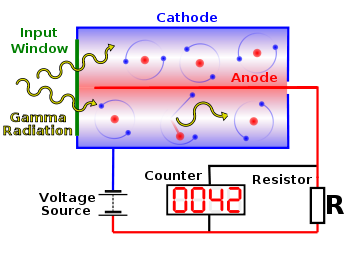Ionizing radiation is measured by a device called a Geiger counter. The Geiger counter is named after its inventor Hans Geiger who created the Geiger counter in 1908. Walther Müller collaborated on improving the counter in 1928 and the counters are also called Geiger-Mueller counters.
The heart of a Geiger counter is the Geiger-Müller (GM) tube. The GM tube is filled with a gas (usually neon) at a low pressure of about one tenth of normal atmospheric pressure at sea level. The tube is either made of a conductive metal or is coated with a conductive substance. There is a conductive wire in the center of the tube separated by insulators from the conductive shell. A potential of several hundred volts is maintained between the positively charged conductive wire or anode and the negatively charged conductive shell or cathode.
When the tube is subjected to ionizing radiation, some of the gas is ionized creating pairs of electrons and positively charged ions. The positive ions are attracted to the cathode and the electrons are attracted to the anode. The strong electrical charge between the anode and the cathode causes the ions and electrons to accelerate and collide with more gas atoms which results in a cascade of electrons and ions. The ultimate result is a brief strong pulse of current flow from the cathode to the anode. This pulse is counted as an indicator of ionizing radiation, hence the name counter for this instrument. Some Geiger counters also have an audio amplifier which lets the instrument emit an audible pulse or click when it encounters radiation.
The exact behavior of the GM tube is governed by a complex relationship between the level of voltage and the effected triggered by the radiation. There is an optimal voltage range for a given GM tube. Below that voltage range, the incoming radiation will not trigger a reaction and above that range, the cascade reaction will saturate and all the gas in the tube will be ionized. It is necessary to have a well regulated and stable voltage source for a GM tube to give reliable readings.
One end of the GM tube is sealed and opaque to some radiation. The other end contains the end-window. A glass end GM tube cannot detect alpha radiation because it is blocked by the glass. Mica end GM tubes can detect alpha, beta, X-ray and Gamma radiation although the common types of GM tubes are inefficient at detecting Gamma. GM tubes do not normally detect neutrons because they are neutral and do not react with the gas in the tube. Special GM tubes coated with boron or containing tritium gas are able to detect neutrons.
In order to insure that the GM tube accurately registers just one pulse per ionizing particle, it is necessary to quench any secondary activity triggered by the entering particle. However, this quenching temporarily renders the GM tube unable to detect additional particles arriving at the tube. The time required to regain sensitivity is known as the dead time. Quenching can be accomplished by external electronics, by adding organic vapors of butane or ethanol to the gas in the tube. Currently, most GM tubes employ a design that was invented by Stanly Liebson in 1947 to take advantage of a halogen gas effect that allows a lower voltage to be utilized in the tubes.
